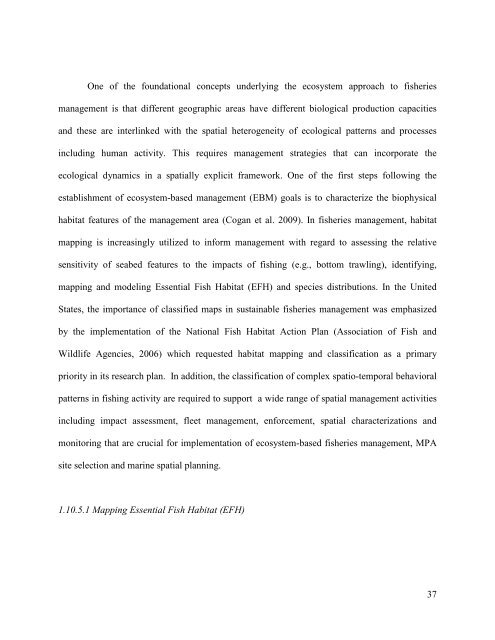1 1.10 Application of estuarine and coastal classifications in marine ...
1 1.10 Application of estuarine and coastal classifications in marine ...
1 1.10 Application of estuarine and coastal classifications in marine ...
You also want an ePaper? Increase the reach of your titles
YUMPU automatically turns print PDFs into web optimized ePapers that Google loves.
One <strong>of</strong> the foundational concepts underly<strong>in</strong>g the ecosystem approach to fisheries<br />
management is that different geographic areas have different biological production capacities<br />
<strong>and</strong> these are <strong>in</strong>terl<strong>in</strong>ked with the spatial heterogeneity <strong>of</strong> ecological patterns <strong>and</strong> processes<br />
<strong>in</strong>clud<strong>in</strong>g human activity. This requires management strategies that can <strong>in</strong>corporate the<br />
ecological dynamics <strong>in</strong> a spatially explicit framework. One <strong>of</strong> the first steps follow<strong>in</strong>g the<br />
establishment <strong>of</strong> ecosystem-based management (EBM) goals is to characterize the biophysical<br />
habitat features <strong>of</strong> the management area (Cogan et al. 2009). In fisheries management, habitat<br />
mapp<strong>in</strong>g is <strong>in</strong>creas<strong>in</strong>gly utilized to <strong>in</strong>form management with regard to assess<strong>in</strong>g the relative<br />
sensitivity <strong>of</strong> seabed features to the impacts <strong>of</strong> fish<strong>in</strong>g (e.g., bottom trawl<strong>in</strong>g), identify<strong>in</strong>g,<br />
mapp<strong>in</strong>g <strong>and</strong> model<strong>in</strong>g Essential Fish Habitat (EFH) <strong>and</strong> species distributions. In the United<br />
States, the importance <strong>of</strong> classified maps <strong>in</strong> susta<strong>in</strong>able fisheries management was emphasized<br />
by the implementation <strong>of</strong> the National Fish Habitat Action Plan (Association <strong>of</strong> Fish <strong>and</strong><br />
Wildlife Agencies, 2006) which requested habitat mapp<strong>in</strong>g <strong>and</strong> classification as a primary<br />
priority <strong>in</strong> its research plan. In addition, the classification <strong>of</strong> complex spatio-temporal behavioral<br />
patterns <strong>in</strong> fish<strong>in</strong>g activity are required to support a wide range <strong>of</strong> spatial management activities<br />
<strong>in</strong>clud<strong>in</strong>g impact assessment, fleet management, enforcement, spatial characterizations <strong>and</strong><br />
monitor<strong>in</strong>g that are crucial for implementation <strong>of</strong> ecosystem-based fisheries management, MPA<br />
site selection <strong>and</strong> mar<strong>in</strong>e spatial plann<strong>in</strong>g.<br />
<strong>1.10</strong>.5.1 Mapp<strong>in</strong>g Essential Fish Habitat (EFH)<br />
37
















